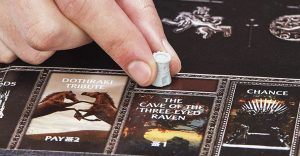How Mortal Kombat’s Krypt Evolved Over The Years

The Krypt in Mortal Kombat has been a recurring feature of the fighting game franchise for a number of installments, often serving one of several purposes. What started as a relatively small feature used to unlock items in its earliest renditions has since adapted and evolved with each successive release, now having become its own miniature adventure mode in the latest installment. While the implementation of the mode has changed from its early days, the Krypt continues to engage players of the Mortal Kombat franchise in methods outside of its main combat.
In the early days of Mortal Kombat, most unlockables were handled through cheat codes in the console versions, the Kombat Kodes during Vs. mode matches, or by completing the various towers, but the games always lacked a place for the player to simply unlock an item they wanted for permanent use. When Mortal Kombat made the jump to the sixth generation of gaming, the company then known as Midway would find a way to incentivize playing the game for unlockable items that the player would get to keep as their own.
Making its first appearance in 2002’s Mortal Kombat: Deadly Alliance, the Krypt started as a very modest affair. Set in a graveyard, the player is met with a grid of headstones organized by the letters of the alphabet from AA to ZZ, totaling in 676 headstones. Here, players can use one of various types of Koins that’ve earned through playing any of the game’s Kombat modes, allowing them to open the Koffins within the graves to unlock a variety of items including hidden characters, costumes, Koncept art, movies, and print ads used through the history of the series. Hidden among the Krypt’s treasures, however, were various gag items meant for a laugh, hints at other items, or, in the worst case, nothing at all.
How Mortal Kombat’s Krypt Evolved

Mortal Kombat: Deception in 2004 used a similar system, trimming down the Krypt to 400 Koffins in an effort to streamline the process as well as eliminate the use of empty Koffins meant for padding within the previous Krypt. To create a feeling of life in the otherwise-drab environment, other characters can now be seen running from Koffin to Koffin in the background, allowing non-playable characters to cameo within Mortal Kombat’s Krypt. Keys can also be found in Konquest Mode for players to open locked Koffins for their unlockables. This would be the final version of the Krypt that would be structured in this manner, with Mortal Kombat: Armageddon in 2006 simplifying the process once more.
The Krypt in Mortal Kombat: Armageddon used a new system entirely, condensing the Koin system from the previous installments into a single type of Koin Kurrency. Instead of selecting from a 20×20 or 26×26 grid, the items of the Krypt are divided into one of three categories: Kontent, media, or Koncept art. The items are also all clearly marked, allowing the player to make an informed decision on how they would like to spend their Koins and removing the gag items entirely. As one last overhaul of the system, items in the Krypt can either be unlocked through purchase or via the game’s Konquest Mode. As the Mortal Kombat series transitioned into the “next generation” at the time, this simplified Krypt interface would be cast to the wayside, making way for the start of a more interactive Krypt.
Mortal Kombat (2011) brought the Krypt back into the fold, retooled entirely with a new system for exploring. The Krypt was now a map onto itself, split into four different sections of the Mortal Kombat world and the Nekropolis, which served as the location for players to view character profiles and any unlocked items. Lurking through the Krypt, however, was the first occurrence of a “jump scare” in the form of the random appearance of the Flesh Pits Mutant that would appear on-screen and scream before vanishing away. Mortal Kombat X borrows elements of this version of the Krypt and simply expands on the locations, the exploration, and the surprises as different monsters can attack the player while exploring, prompting a quicktime event to fend them off. This version of the Krypt would be the start of what it would become in the following installment.

The next game in the franchise, Mortal Kombat 11, would see a full “revamp” of the Krypt, introducing a character-based narrative and backstory as to why the player wanders the world. In this rendition, players control a character called the “Descendant of Apep,” a descendant of Shujinko’s friend, Apep, from the Konquest Mode in Mortal Kombat: Deception. The player’s character arrives at Shang Tsung’s Island, which serves as the backdrop for the Krypt in this installment, as Shang Tsung himself not only greets the traveler, but he serves as narrator and overseer of the Krypt, commenting on the player’s path and watching their every move.
Along with this new narrative, the Krypt has become a third-person adventure, and players now are tasked with exploring Shang Tsung’s Island and visiting many familiar locations from the history of Mortal Kombat, one which is even sporting several Easter eggs from the original movie adaptation. Koins are back, with two other, rarer kurrencies: Souls and Hearts, with an assortment of treasure chests scattered through the Krypt that contain an assortment of unlockables in the vein of the previous renditions of the Krypt as well as items and ingredients to be used in the Krypt itself, encouraging exploration to open rooms and portions of the island.

What started as a modest mode for unlocks grew and evolved into a more interactive experience, allowing players to see, first-hand, some of the universe of Mortal Kombat for the first time since the Konquest Modes of Deception and Armageddon. After outgrowing its original status as a dispensary for unlocks, the Krypt in Mortal Kombat 11 is proof that the minds at NetherRealm Studios can step out of their comfort zones, creating a mini-adventure mode with its own narrative to set the tone for the journey while presenting their gorgeous and gory world to their audience through the eyes of the Descendant of Apep. While the audience doesn’t see the fate that befalls the Descendant of Apep during his Krypt journey, Mortal Kombat 11: Aftermath gives us a visceral image of what happens to the man who wandered Shang Tsung’s Island.
Every version of the Krypt has given players a glimpse of the world of Mortal Kombat. From the dark graveyards of the dead to the exploration of the world’s various locations, the Krypt has served as a holding place for the game’s unlockables before evolving into what can only be described as a theme park and museum based on the world of Mortal Kombat, with Shang Tsung serving as the tour guide through the traps and treasures that await the player. While it was introduced a decade after the start of the series, the Krypt has been adapted with each installment, ensuring its longevity and making the Krypt a mainstay in the history of Mortal Kombat.
About The Author


















